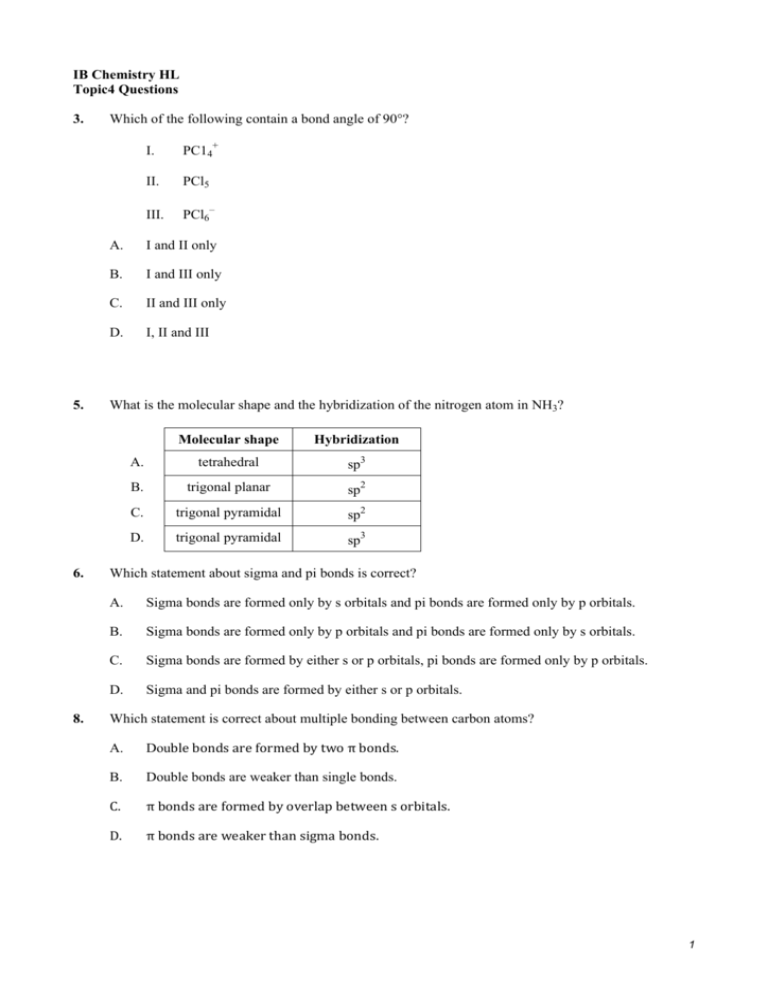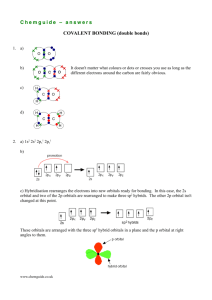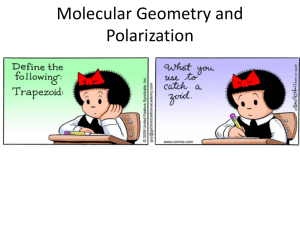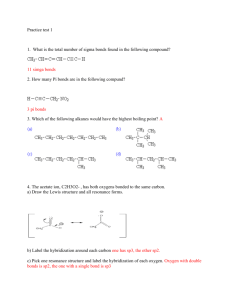bonding hl student
advertisement

IB Chemistry HL Topic4 Questions 3. 5. 6. 8. Which of the following contain a bond angle of 90°? I. PC14+ II. PCl5 III. PCl6– A. I and II only B. I and III only C. II and III only D. I, II and III What is the molecular shape and the hybridization of the nitrogen atom in NH3? Molecular shape Hybridization A. tetrahedral sp3 B. trigonal planar sp2 C. trigonal pyramidal sp2 D. trigonal pyramidal sp3 Which statement about sigma and pi bonds is correct? A. Sigma bonds are formed only by s orbitals and pi bonds are formed only by p orbitals. B. Sigma bonds are formed only by p orbitals and pi bonds are formed only by s orbitals. C. Sigma bonds are formed by either s or p orbitals, pi bonds are formed only by p orbitals. D. Sigma and pi bonds are formed by either s or p orbitals. Which statement is correct about multiple bonding between carbon atoms? A. Double bonds are formed by two π bonds. B. Double bonds are weaker than single bonds. C. π bonds are formed by overlap between s orbitals. D. π bonds are weaker than sigma bonds. 1 9. 10. 11. 12. Which particles can act as ligands in complex ion formation? I. C1– II. NH3 III. H 2O A. I and II only B. I and III only C. II and III only D. I, II and III Which statements correctly describe the NO2– ion? I. It can be represented by resonance structures. II. It has two lone pairs of electrons on the N atom. III. The N atom is sp2 hybridized. A. I and II only B. I and III only C. II and III only D. I, II and III Which is the smallest bond angle in the PF5 molecule? A. 90° B. 109.5° C. 120° D. 180° Which types of hybridization are shown by the carbon atoms in the compound CH2 = CH−CH3? I. sp II. sp2 III. sp3 A. I and II only B. I and III only 2 13. C. II and III only D. I, II and III Identify the types of hybridization shown by the carbon atoms in the molecule CH3CH2CH2COOH 14. 15. 16. I. sp II. sp2 III. sp3 A. I and II only B. I and III only C. II and III only D. I, II and III Which molecule is square planar in shape? A. XeO4 B. XeF4 C. SF4 D. SiF4 What is the hybridization of nitrogen atoms I, II, III and IV in the following molecules? I II III IV A. sp2 sp2 sp3 sp3 B. sp3 sp3 sp2 sp2 C. sp2 sp2 sp sp D. sp3 sp3 sp sp What is the molecular geometry and the Cl–I–Cl bond angle in the ICl4– ion? A. Square planar 90° B. Square pyramidal 90° C. Tetrahedral 109° 3 D. 17. 18. 19. 20. Trigonal pyramidal 107° What is the geometry of the bonds around an atom with sp2 hybridization? A. 2 bonds at 180° B. 3 bonds at 120° C. 2 bonds at 90°, 1 bond at 180° D. 4 bonds at 109° How many sigma (σ) and pi (π) bonds are present in the structure of HCN? σ π A. 1 3 B. 2 3 C. 2 2 D. 3 1 How many lone pairs and bonding pairs of electrons surround xenon in the XeF4 molecule? Lone pairs Bonding pairs A. 4 8 B. 0 8 C. 0 4 D. 2 4 (a) Explain the meaning of the term hybridization. .................................................................................................................................... .................................................................................................................................... (1) (b) State the type of hybridization shown by the carbon atom in the H–C≡N molecule, and the number of σ and π bonds present in the C≡N bond. .................................................................................................................................... .................................................................................................................................... (2) (c) Describe how σ and π bonds form. .................................................................................................................................... .................................................................................................................................... .................................................................................................................................... 4 .................................................................................................................................... (4) (Total 7 marks) 23. Atomic orbitals can mix by hybridization to form new orbitals for bonding. Identify the type of hybridization present in each of the three following molecules. Deduce and explain their shapes. (i) OF2 …………………………………………………………………………………………… …………………………………………………………………………………………… …………………………………………………………………………………………… …………………………………………………………………………………………… (3) (ii) H2CO …………………………………………………………………………………………… …………………………………………………………………………………………… …………………………………………………………………………………………… …………………………………………………………………………………………… (3) (iii) C 2H 2 …………………………………………………………………………………………… …………………………………………………………………………………………… …………………………………………………………………………………………… …………………………………………………………………………………………… (3) (Total 9 marks) 24. For the following compounds PCl3, PCl5, POCl3 (i) Draw a Lewis structure for each molecule in the gas phase. (Show all non-bonding electron pairs.) ..................................................................................................................................... ..................................................................................................................................... ..................................................................................................................................... 5 ..................................................................................................................................... ..................................................................................................................................... ..................................................................................................................................... ..................................................................................................................................... ..................................................................................................................................... ..................................................................................................................................... ..................................................................................................................................... (3) (ii) State the shape of each molecule and predict the bond angles. ..................................................................................................................................... ..................................................................................................................................... ..................................................................................................................................... ..................................................................................................................................... ..................................................................................................................................... ..................................................................................................................................... (6) (iii) Deduce whether or not each molecule is polar, giving a reason for your answer. ..................................................................................................................................... ..................................................................................................................................... ..................................................................................................................................... ..................................................................................................................................... ..................................................................................................................................... ..................................................................................................................................... (3) (Total 12 marks) 25. (i) Explain the meaning of the term hybridization. ..................................................................................................................................... ..................................................................................................................................... ..................................................................................................................................... (1) (ii) Discuss the bonding in the molecule CH3CHCH2 with reference to • the formation of σ and π bonds • the length and strength of the carbon-carbon bonds 6 • the types of hybridization shown by the carbon atoms ..................................................................................................................................... ..................................................................................................................................... ..................................................................................................................................... ..................................................................................................................................... ..................................................................................................................................... ..................................................................................................................................... ..................................................................................................................................... ..................................................................................................................................... (6) (Total 7 marks) 26. (a) Draw the Lewis structures for the compounds XeF4, PF5 and BF4–. (3) (b) Use the valance shell electron pair repulsion (VSEPR) theory to predict the shapes of the three compounds in (a). State and explain the bond angles in each of the three compounds. (3) (Total 6 marks) 27. (a) State the meaning of the term hybridization. State the type of hybridization shown by the nitrogen atoms in N2, N2H2 and N2H4. (4) (b) By referring to the N2H2 molecule describe how sigma (σ) and pi (π) bonds form and describe how single and double bonds differ. (4) (Total 8 marks) 28. (i) Explain why the first ionization energy of magnesium is lower than that of fluorine. (2) (ii) Write an equation to represent the third ionization energy of magnesium. Explain why the third ionization energy of magnesium is higher than that of fluorine. (3) (Total 5 marks) 29. Draw the Lewis structures, state the shapes and predict the bond angles for the following species. (i) PCl5 (3) (ii) SCl2 (3) (iii) ICl4– (3) (Total 9 marks) 7 30. (a) (i) State the meaning of the term hybridization. (1) (ii) State the type of hybridization around the carbon atoms in C60 fullerene, diamond and graphite. (3) (iii) Explain why graphite and C60 fullerene can conduct electricity. (2) (b) (i) Compare how atomic orbitals overlap in the formation of sigma (σ) and pi (π) bonds. (2) (ii) State the number of sigma bonds and pi bonds in H2CC(CH3)CHCH2. (2) (Total 10 marks) 31. (i) Apply the VSEPR theory to deduce the shape of , ICl5 and SF4. For each species, draw the Lewis (electron dot) structure, name the shape, and state the value of the bond angle(s). (9) (ii) Discuss the bond angle(s) in SF4. (1) (iii) Explain the hybridization involved in the C2H4 molecule. (4) (iv) State the hybridization involved in the bond distances. ion and comment on the nitrogen-oxygen (2) (v) Using Table 7 of the Data Booklet, predict and explain which of the bonds O-H, O-N or N-H would be most polar. (2) (Total 18 marks) IB Chemistry HL Topic4 Answers 3. 5. C D 6. C 8. 9. D D 10. B 8 11. A 12. C 13. C 14. B 15. B 16. A 17. B 18. C 19. D 20. (a) (b) mixing/joining together/combining/merging of atomic orbitals to form molecular orbitals/new orbitals/orbitals of equal energy; Accept specific example such as mixing of s and p orbitals. 1 sp; Do not award mark if sp2 or sp3 is also stated. one sigma and two pi (bonds); (c) 2 (σ bond formed by) end-on/axial overlap; electrons/electron density between the two (carbon) atoms/OWTTE; (π bond formed by) sideways/parallel overlap; electrons/electron density above and below σ bond/OWTTE; Marks can be scored from a suitable diagram. 4 Do not award 2nd and 4th marks if electrons are not mentioned. [7] 23. (i) (ii) (iii) OF2 sp3; V-shaped/bent/angular; 2 bonding + 2 non-bonding (electron pairs); H2CO sp2; trigonal planar; 2 areas of electron density/negative charge centres; C 2H 2 sp; linear; 2 areas of electron density/negative charge centres; Accept suitable diagrams for shapes. Allow [2] for ECF if correct explanation given for incorrect formula, e.g. C2H4. 3 3 3 [9] 9 24. (i) Award [1] for each correct Lewis structure. 3 Accept use of dots or crosses to represent electron pairs. Subtract [1] if non-bonding pair on P in PCl3 is missing. Subtract [1] if non-bonding pair(s) on Cl or O are missing. Accept legitimate alternatives for POCl3, e.g. see below. (ii) PCl3 trigonal pyramid; Accept answers in range 100° to 108°; PCl5 trigonal bipyramid; 90° and 120°; POCl3 tetrahedral; Accept answers in range 100° to 112°; Allow ECF if based on legitimate chemical structure. 6 10 (iii) PCl3 polar, polarities do not cancel/OWTTE; PCl5 non-polar, polarities cancel/OWTTE; POCl3 polar, polarities do not cancel/OWTTE; 3 Award [2] for three polarities correct, [1] for two polarities correct, and [1] for correct reason(s). Accept argument based on dipole moments. Allow ECF if based on legitimate chemical structure. [12] 25. (i) combining of atomic orbitals to form new orbitals/OWTTE; (ii) σ : overlap of orbitals between nuclei/end-on overlap; π : overlap above and below line joining nuclei/sideways overlap; Award [1] if candidate counts bonds (8 σ, 1 π), or describes all three types of bonds (i.e. C—H is σ, C—C is σ, C=C is σ and π). 1 single bonds longer than double; double bonds stronger than single; C of CH3 is sp3; other two C are sp2; Accept suitable diagrams. 6 [7] 26. (a) 3 11 Accept any combination of dots, crosses and lines. Penalise missing fluorine lone pairs once only. (b) XeF4 Square planar and 90°; PF5 trigonal bipyramid and 90° and 120°; BF4– Tetrahedral and 109.5°/109°; Allow clear suitable diagrams instead of name. No ECF from (a). 3 [6] 27. (a) hybridization: mixing/merging of atomic orbitals; N2 −sp; N2H2 −sp2; N2H4 −sp3; (b) σ bonds (result from the) overlapping of orbitals end to end/along inter-nuclear axis; π bonds (result from the) overlapping of parallel/sideways p orbitals; (single bonds) σ bonds only; (double bonds) have a σ bond and a π bond; Suitable clear and labelled diagrams acceptable for all marks. 4 4 [8] 28. (i) electron removed from higher energy level/further from nucleus/greater atomic radius; increased repulsion by extra inner shell electrons/increased shielding effect; (ii) 2 Mg2+(g) → Mg3+(g) + e; (even though) valence electrons in the same shell/main energy level/ Mg2+ has noble gas configuration; Mg has greater nuclear/core charge/more protons; 3 [5] 29. (i) trigonal bipyramidal; 12 90°; 120°; 180°; 3 Award [1] for 2 correct bond angles. (ii) Bent/angular/V-shaped; 100°−107°; 3 (iii) square planar; 90°; No ECF allowed. Penalize once only [1] mark for missing lone pairs. Accept structures using lines to represent bonding and lone electron pairs. 3 [9] 30. (a) (i) mixing/combining of atomic orbitals/OWTTE; (ii) C60 fullerene: sp2; 1 graphite : sp2; (iii) (b) (i) diamond: sp3; 3 each carbon atom is bound to 3 other carbon atoms/π bonding; leading to delocalized electrons; 2 sigma/σ bonds are formed by orbitals overlapping end to end/ along the internuclear axis/along line directly between nuclei; Accept suitable diagram. pi/π bonds are formed by p orbitals overlapping sideways; Accept suitable diagram. (ii) 12 sigma bonds; 2 pi bonds; 2 2 [10] 13 31. (i) Species NO2– ICl5 SF4 Lewis (electron-dot) structure Shape Bond angle(s) Bent/Vshaped/angular; 109.5° < θ < 120°; Square pyramidal; |Inplane Cl-I-out-of-plane Cl| < 90°; Allow corresponding correct statement for other correctly identified bond angles. See-saw; |Equatorial F-S-Equatorial F| < 120°; Allow corresponding correct statement for axial-equatorial and axial-axial F-S-F angles. 9 Accept crosses and dots for electrons in the Lewis structures also. If all ideal bond angles are given, penalize once only. As the Lewis structures were asked for, and not 3D representations, do not penalize incorrectly drawn geometries. (ii) (iii) (iv) (v) (equatorial F-S-equatorial F) less than 120° since non-bonding electron pairs (exert greater repulsive forces and thus) compress the bond angles/OWTTE; 1 orbital diagram representation of carbon ground-state going to carbon excited-state electron configuration; mixing of orbitals to give three new entirely equivalent hybrid orbitals, sp2, on each carbon; sp2 orbitals trigonal (triangular) planar in shape; unhybridized orbitals overlap to give π-­‐bond; 4 sp2; both N-O bond lengths equal, (intermediate between double and single bonds) due to resonance/delocalisation; 2 O-H is most polar; O-H has greatest difference between electronegativities/calculation showing values of 1.4, 0.5 and 0.9 respectively; 2 [18] 14








